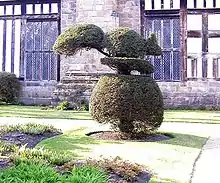topiary
English
Etymology
From Latin topiarius (“of or relating to ornamental gardening; an ornamental garden, an ornamental gardener”), from Latin topia (“ornamental gardening, landscape painting”), from Ancient Greek τόπια (tópia, “artistic representation in which natural or artificial features of a place are used as the medium”), plural of Ancient Greek τόπιον (tópion, “field, landscape”), from τόπος (tópos, “place”). The adjective use dates to 1592, the noun use dates to 1908.
Pronunciation
- (UK) IPA(key): /ˈtəʊpjəɹi/
- (General American) IPA(key): /ˈtoʊpiˌɛəɹi/
Adjective
topiary (not comparable)
- Of, or relating to art of topiaries.
- 1910, American homes and gardens: Volume 7:
- As the topiary art has been allowed to practically die out, it is difficult to secure the services of skilled clippers.
- Of a tree or shrub, trimmed in artistic shape.
Translations
relating to the art of topiaries
|
trimmed in artistic shape
|
Noun
topiary (countable and uncountable, plural topiaries)

The topiary of a squirrel.
- (uncountable) Art or practice of trimming shrubs or trees in artistic or ornamental shapes, e.g. of animals.
- 1994, Robert Jordan, Lord of Chaos, prologue:
- The palace garden might have had a semblance of coolness had there been any trees, but the tallest things were fanciful topiary, tortured into the shapes of running horses or bears performing tumblers’ tricks or the like.
- (countable) A garden decorated with such art.
- (countable) One such shrub or tree.
- We have topiaries for sale.
Translations
art or practice
|
garden
shrub
|
See also
This article is issued from Wiktionary. The text is licensed under Creative Commons - Attribution - Sharealike. Additional terms may apply for the media files.